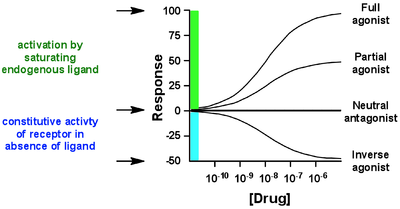Inverse agonist

In the field of pharmacology, an inverse agonist is an agent that binds to the same receptor as an agonist but induces a pharmacological response opposite to that agonist.
A prerequisite for an inverse agonist response is that the receptor must have a constitutive (also known as intrinsic or basal) level activity in the absence of any ligand. An agonist increases the activity of a receptor above its basal level, whereas an inverse agonist decreases the activity below the basal level. A neutral antagonist has no activity in the absence of an agonist or inverse agonist but can block the activity of either.[1]
The efficacy of a full agonist is by definition 100%, a neutral antagonist has 0% efficacy, and an inverse agonist has < 0% (i.e., negative) efficacy.
Examples
An example of a receptor that possesses basal activity and for which inverse agonists have been identified is the GABAA receptor. Agonists for the GABAA receptor (such as the benzodiazepines alprazolam and diazepam) elicit a sedative effect, whereas inverse agonists have anxiogenic (for example, Ro15-4513) or even convulsive effects (certain beta-carbolines).[2][3]
Two known endogenous inverse agonists are the Agouti-related peptide (AgRP) and its associated peptide Agouti signaling peptide (ASIP). Both are expressed in humans, and each binds melanocortin receptors 4 and 1 (Mc4R and Mc1R), respectively, with nanomolar affinities.[4]
References
- ^ Kenakin T (2004). "Principles: receptor theory in pharmacology". Trends Pharmacol. Sci. 25 (4): 186–92. doi:10.1016/j.tips.2004.02.012. PMID 15063082.
- ^ Mehta AK, Ticku MK (1988). "Ethanol potentiation of GABAergic transmission in cultured spinal cord neurons involves gamma-aminobutyric acidA-gated chloride channels". J. Pharmacol. Exp. Ther. 246 (2): 558–64. PMID 2457076.
- ^ Sieghart W (1994). "Pharmacology of benzodiazepine receptors: an update". J Psychiatry Neurosci. 19 (1): 24–9. PMC 1188559. PMID 8148363.
- ^ Ollmann MM, Lamoreux ML, Wilson BD, Barsh GS (1998). "Interaction of Agouti protein with the melanocortin 1 receptor in vitro and in vivo". Genes Dev. 12 (3): 316–30. doi:10.1101/gad.12.3.316. PMC 316484. PMID 9450927.
{{cite journal}}: Unknown parameter|month=ignored (help)CS1 maint: multiple names: authors list (link)
See also
External links
- Jeffries WB (1999-02-17). "Inverse Agonists for Medical Students". Office of Medical Education - Courses - IDC 105 Principles of Pharmacology. Creighton University School of Medicine - Department of Pharmacology. Retrieved 2008-08-12.
{{cite web}}: Cite has empty unknown parameter:|coauthors=(help) - Inverse Agonists: An Illustrated Tutorial Panesar K, Guzman F. Pharmacology Corner. 2012
